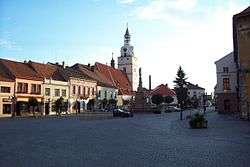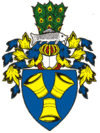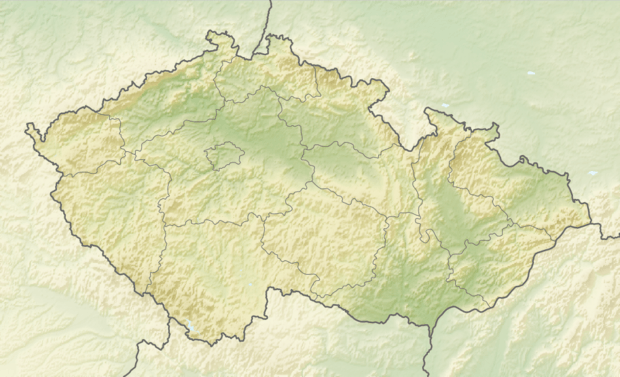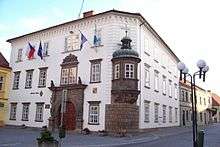Ivančice
Ivančice (Czech pronunciation: [ˈɪvantʃɪtsɛ]; German: Eibenschütz, Yiddish: אייבעשיץ) is a town in the South Moravian Region of the Czech Republic, 21 kilometres (13 mi) south-west of Brno. The town has approximately 9,700 inhabitants. It lies on the confluence of Oslava, Jihlava and Rokytná rivers.
Ivančice | |
|---|---|
Town | |
 Palacký Square in Ivančice | |
 Flag  Coat of arms | |
 Ivančice Location in the Czech Republic | |
| Coordinates: 49°6′5″N 16°22′39″E | |
| Country | Czech Republic |
| Region | South Moravian |
| District | Brno-Country |
| First mentioned | 1221 |
| Government | |
| • Mayor | Milan Buček |
| Area | |
| • Total | 47.57 km2 (18.37 sq mi) |
| Elevation | 210 m (690 ft) |
| Population (2019-01-01[1]) | |
| • Total | 9,742 |
| • Density | 200/km2 (530/sq mi) |
| Time zone | UTC+1 (CET) |
| • Summer (DST) | UTC+2 (CEST) |
| Postal code | 664 91 |
| Website | www.ivancice.cz |
History
Ivančice was first mentioned in 1221, and from 1288 it had the status of a royal town. In the fifteenth century the town came into the hands of the von Lipá family, and it stayed in their possession until the Battle of White Mountain. In the sixteenth century, the town was an important centre for the Unity of the Brethren; Ivančice was home to Jan Blahoslav, bishop of the brethren and Czech linguist. In the Thirty Years' War Ivančice was recatholicised and lost its previous significance.
Ivančice was the birthplace of Art Nouveau painter and decorative artist Alphonse Mucha. The town is now home to a museum of the life of actor Vladimír Menšík.
History of the Jewish Community in Ivančice
The Jewish community is one of the oldest in Moravia. Local tradition says that Jews originally arrived with Roman troops in the first century, although they were expelled from the town later.
The rule of the House of Premysl (895–1306) was a period of relative comfort and prosperity for the Jews of Ivančice. They worked with their Christian neighbors to build the town walls, and also to defend them. However, they were not allowed to carry arms or to work in the government.
A Jewish ghetto was established during the 14th century, and was placed outside the town proper. Later it was moved inside the town walls but administered as an independent municipality, with its own Jewish mayor. During this period Jews inside the ghetto as well as various outside settlements were under the protection of the nobles of the House of Pernstein. In 1454 Jewish refugees from other towns in Moravia as well as from Austria found refuge in Ivančice, making it the largest Jewish community in Moravia for a time. The reign of King Ferdinand of Habsburg in the early 16th century placed economic restrictions on the Jews of Ivančice. The Counter Reformation and the Thirty Years' War (1618–1648) reduced the number of Protestants living in Ivančice, while at the same time the Jewish community grew thanks to the arrival of refugees from Bohemia. This growth resulted in an edict issued in 1650 forbidding any Jews to inhabit Moravia who had not resided there prior to 1618.
A formal Jewish community, including a rabbi, dyanim (religious court), a gabbai, a chevra kaddisha, and a rabbinical school was established during the 17th century. The first rabbi was Abraham, son of Hirsch Foreis, who served in the second half of the 17th century. His successor was Rabbi David of Rakov, who was succeeded by Rabbi Joseph Rakov, his son. He was followed by Rabbi Elia ben Schmuel, Rabbi Nathan Zelig of Cracow, Rabbi Issachar ber Oppenheim (1829-1859), his son Rabbi Joachim Oppenheim, Rabbi Dr. Jacob Tauber, and Rabbi Dr. Hermann Handel (1881–1925). From 1925 on, the community followed the rabbi of Kanits, Dr. Heinrich Flesch.
The town's original synagogue was built in the 16th century. That building was replaced in 1853 by a structure which survives today, and is still in use. It was remodeled in 2008.
The Jewish cemetery dates to 1552, the date of the oldest tombstone. It was expanded in the 17th century, and again in the 19th century. A ceremonial hall was built in 1902.
Before World War II, there were a total of 73 homes in the Jewish Quarter, of which 52 remain. At 1 Krumlovská Street there is a plaque memorializing the concentration camp where Jews were imprisoned from 1938–1942, and from which they were sent off to other camps for extermination. [2]
Notable people
- Jan Blahoslav (1523–1571), humanist writer, Christian theologian, historian, and bishop of the Moravian Church
- Christian Entfelder (1526–1544), anabaptist
- Petrus Herbert (Hubert) (1533–1571), Protestant theologian
- Karl von Zerotein, the Elder (German: Karl der Ältere von Zerotein, Czech: Karel starší ze Žerotína (1564–1636), Moravian nobleman and politician; a member of the House of Zierotin
- Leopold Adler (1850–1990), Jewish actor, director and playwright, acted in Germany
- Guido Adler (1855–1941), Jewish musicologist
- Alfons Mucha (1860–1939), painter
- Arthur Franzetti, né Jellinek (1873–1928), actor, writer
- Karel Sokol Elgart (1874–1929), writer, playwright, and literary critic
- Jiří Dvořák (1891–1977), painter
- Theodor Kilian (1894–1978), Esperantist
- Hugo Weisgall (1912–1997), Jewish composer
- Vladimír Menšík (1929–1988), actor
- Jan Procházka (1929–1971), writer and film director
- Vojtěch Adam (born 1950), politician, and doctor
- Tereza Fajksová (born 1989), Miss Czech Republic Earth 2012, Miss Earth 2012 titleholder
- Beneš Metod Kulda (1820–1903), priest, writer, and ethnologic collector (folk songs and fairy tales)
- Jaroslav Matějka (1927–2010), writer, screenwriter, journalist, filmmaker, and historian
- Václav Novotný (1869–1932), historian
- Joachim Oppenheim (1832–1891), writer and rabbi
- Karl Panowsky (1833–1894), miller and politician
- Zdeněk Růžička (born 1925), gymnast
- Václav Solín (1527–1566), musician, writer and administrator of the printery of Ivančice
- Augustin Uher (1908–1985), journalist, writer and historian
- Eibenschütz pedigree
- Auerbach pedigree
Twin towns — sister cities
Ivančice is twinned with:[3]
References
- "Population of municipalities of the Czech republic". Czech Statistical Office. Retrieved 2019-04-30.
- "The Jewish Community of Ivancice". Bet Hatfutsot – The Museu of the Jewish People. Retrieved 22 March 2019.
- "Úvodní strana" (in Czech). Město Ivančice. Retrieved 2019-08-25.
